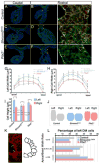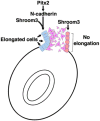Shroom3 and a Pitx2-N-cadherin pathway function cooperatively to generate asymmetric cell shape changes during gut morphogenesis
- PMID: 21726547
- PMCID: PMC3619216
- DOI: 10.1016/j.ydbio.2011.06.027
Shroom3 and a Pitx2-N-cadherin pathway function cooperatively to generate asymmetric cell shape changes during gut morphogenesis
Abstract
The cytoskeletal protein Shroom3 is a potent inducer of epithelial cell shape change and is required for lens and neural plate morphogenesis. Analysis of gut morphogenesis in Shroom3 deficient mouse embryos revealed that the direction of gut rotation is also disrupted. It was recently established that Pitx2-dependent, asymmetrical cellular behaviors in the dorsal mesentery (DM) of the early mid-gut, a structure connecting the gut-tube to the rest of the embryo, contribute to the direction of gut rotation in chicken embryos by influencing the direction of the dorsal mesenteric tilt. Asymmetric cell shapes in the DM epithelium are hypothesized to contribute to the tilt, however, it is unclear what lies downstream of Pitx2 to alter epithelial cell shape. The cells of the left DM epithelium in either Pitx2 or Shroom3 deficient embryos are shorter and wider than those in control embryos and resemble the shape of those on the right, demonstrating that like Pitx2, Shroom3 is required for cell shape asymmetry and the leftward DM tilt. Because N-cadherin expression is specific to the left side and is Pitx2 dependent, we determined whether Shroom3 and N-cadherin function together to regulate cell shape in the left DM epithelium. Analysis of mouse embryos lacking one allele of both Shroom3 and N-cadherin revealed that they possess shorter and wider left epithelial DM cells when compared with Shroom3 or N-cadherin heterozygous embryos. This indicates a genetic interaction. Together these data provide evidence that Shroom3 and N-cadherin function cooperatively downstream of Pitx2 to directly regulate cell shape changes necessary for early gut tube morphogenesis.
Copyright © 2011 Elsevier Inc. All rights reserved.
Figures







Similar articles
-
Integration of left-right Pitx2 transcription and Wnt signaling drives asymmetric gut morphogenesis via Daam2.Dev Cell. 2013 Sep 30;26(6):629-44. doi: 10.1016/j.devcel.2013.07.019. Dev Cell. 2013. PMID: 24091014 Free PMC article.
-
Direct activation of Shroom3 transcription by Pitx proteins drives epithelial morphogenesis in the developing gut.Development. 2010 Apr;137(8):1339-49. doi: 10.1242/dev.044610. Development. 2010. PMID: 20332151 Free PMC article.
-
The chirality of gut rotation derives from left-right asymmetric changes in the architecture of the dorsal mesentery.Dev Cell. 2008 Jul;15(1):134-45. doi: 10.1016/j.devcel.2008.05.001. Dev Cell. 2008. PMID: 18606147 Free PMC article.
-
Left-right asymmetry in gut development: what happens next?Bioessays. 2009 Oct;31(10):1026-37. doi: 10.1002/bies.200900056. Bioessays. 2009. PMID: 19708022 Review.
-
Vertebrate left-right asymmetry: old studies and new insights.Cell Mol Biol (Noisy-le-grand). 1999 Jul;45(5):505-16. Cell Mol Biol (Noisy-le-grand). 1999. PMID: 10512183 Review.
Cited by
-
Global analysis of cell behavior and protein dynamics reveals region-specific roles for Shroom3 and N-cadherin during neural tube closure.Elife. 2022 Mar 4;11:e66704. doi: 10.7554/eLife.66704. Elife. 2022. PMID: 35244026 Free PMC article.
-
The interaction between Shroom3 and Rho-kinase is required for neural tube morphogenesis in mice.Biol Open. 2014 Aug 29;3(9):850-60. doi: 10.1242/bio.20147450. Biol Open. 2014. PMID: 25171888 Free PMC article.
-
Shroom3 facilitates optic fissure closure via tissue alignment and reestablishment of apical-basal polarity during epithelial fusion.Dev Biol. 2025 Jun;522:91-105. doi: 10.1016/j.ydbio.2025.03.008. Epub 2025 Mar 18. Dev Biol. 2025. PMID: 40113025 Free PMC article. Review.
-
In vivo high-content imaging and regression analysis reveal non-cell autonomous functions of Shroom3 during neural tube closure.Dev Biol. 2022 Nov;491:105-112. doi: 10.1016/j.ydbio.2022.08.011. Epub 2022 Sep 13. Dev Biol. 2022. PMID: 36113571 Free PMC article.
-
Frs2α enhances fibroblast growth factor-mediated survival and differentiation in lens development.Development. 2012 Dec;139(24):4601-12. doi: 10.1242/dev.081737. Epub 2012 Nov 7. Development. 2012. PMID: 23136392 Free PMC article.
References
-
- Campione M, Steinbeisser H, Schweickert A, Deissler K, van Bebber F, Lowe LA, Nowotschin S, Viebahn C, Haffter P, Kuehn MR, et al. The homeobox gene Pitx2: mediator of asymmetric left-right signaling in vertebrate heart and gut looping. Development. 1999;126(6):1225–34. - PubMed
-
- Gage PJ, Suh H, Camper SA. Dosage requirement of Pitx2 for development of multiple organs. Development. 1999;126(20):4643–51. - PubMed
Publication types
MeSH terms
Substances
Grants and funding
LinkOut - more resources
Full Text Sources
Molecular Biology Databases
Research Materials

